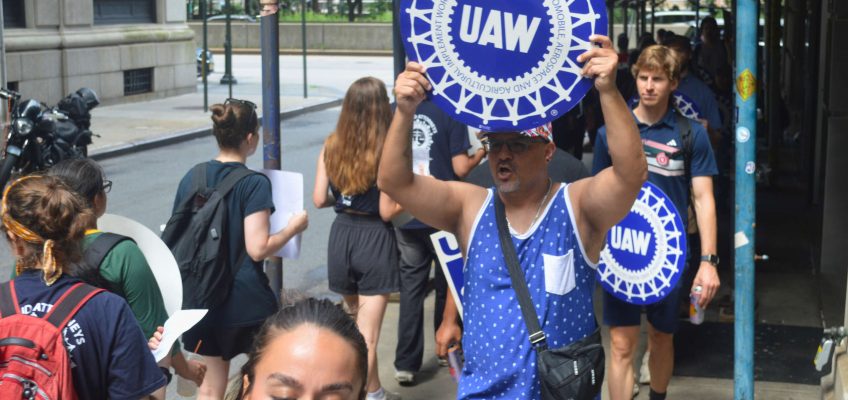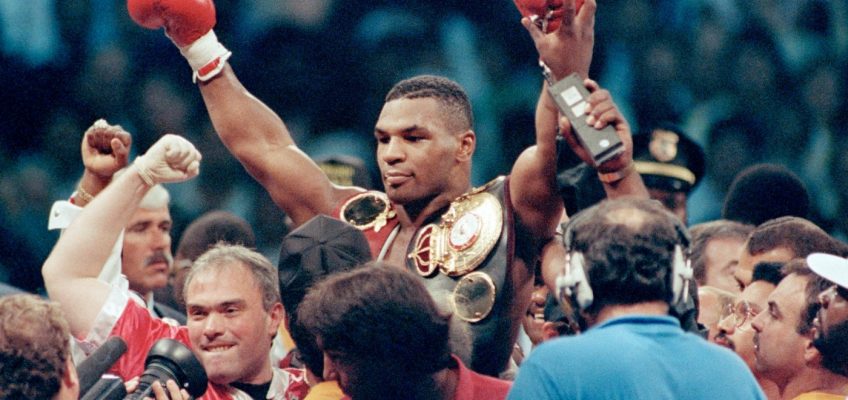Hundreds rallied in Foley Square Tuesday, including over a dozen local politicians—Zohran Mamdani, the Democratic nominee for mayor among them—in a strong show of support for the striking workers, who include attorneys representing low-income tenants in housing court.
Legal services workers picketing outside Urban Justice Center’s offices in Manhattan on Tuesday, July 15. (Tareq Saghie for City Limits)
In July of 2023, the Association of Legal Advocates and Attorneys, UAW Local 2325 (ALAA) passed a resolution to engage in sectoral bargaining for the workers they represent at legal aid organizations across the city.
As part of this strategy, they aligned the workers’ contract expiration dates to June 30 of this year, believing they could achieve more ambitious demands with collective power.
On Tuesday, the plan came to fruition, as workers at the Urban Justice Center and New York Legal Assistance Group (NYLAG) launched a strike in Manhattan’s Foley Square alongside fellow ALAA members at the Goddard Riverside Law Project, who began a strike last Wednesday. Three other shops who might go out Friday joined the rally, as well as workers from several other organizations who authorized a strike but haven’t yet announced a deadline.
The crowd of hundreds, which included over a dozen local politicians—Assemblymember Zohran Mamdani, the Democratic nominee for mayor among them—was a strong show of support for the workers’ demands, and a display of the disruption a strike could cause the courts.
This includes attorneys representing low-income New Yorkers in housing court, where tenants are facing eviction or pursuing building repairs.
“It’s not just about how much our members make. It’s not just about their caseloads. It’s about justice for all New Yorkers who deserve high quality representation,” said Brandon Mancilla, director of UAW Region 9A, which includes New York City. “The shorter the strike, the sooner our members can get back to do the work, but it’s on the organization to ensure that that continues while we have our fight.”
If the legal staff are unable to reach contract agreements with their respective publicly-funded employers, New York City’s courts could be hit by the most disruptive labor conflict since 1994, when over 1,100 ALAA attorneys at the Legal Aid Society went on strike for higher wages, which former Mayor Rudy Giuliani promptly responded to by cutting off the contract that funded their work.
The workers quickly folded then, but Giuliani retaliated by offering the Legal Aid Society’s contracts to new, ununionized organizations, reducing the ALAA’s hold over the sector. Since then, the ALAA has slowly brought these groups into their union, such as the Bronx Defenders, whose workers have a strike deadline this Friday.
This year’s strike is in a completely different political environment, though, defined by Mamdani’s recent landslide win in the Democratic mayoral primary. Before Attorney General Letitia James recounted her experience working at the Legal Aid Society during the 1994 strike, Mamdani took the stage in front of a roaring audience of UAW members.
Assemblymember and Democratic mayoral nominee Zohran Mamdani addressing striking workers at Tuesday’s rally. (Tareq Saghie/City Limits)
“We are facing a president who is seeking to attack the very fabric of this city. In a moment like that, we have to use every single tool at our disposal to protect this city, to protect its people,” he said.
“I look at all of you as the people on the front lines of that protection. You are the people who keep New Yorkers in their homes,” Mamdani added. “You are the people who keep families together. So it is incumbent upon every single one of us to stand with you so that you can continue to afford to do this work.”
Workers across the local legal groups share some demands, such as higher wages, reduced workloads, and transparent disciplinary processes, but units also have unique demands to their individual organizations.
The Urban Justice Center, for example, is structured around specific projects with individual pay scales, meaning workers doing the same role are paid differently in different projects. At times, these projects have split off from the organization into separate affiliates without worker input. ALAA members want consistent compensation across projects and a voice in whether their project splits off.
Workers at the Urban Justice Center are also particularly frustrated with their salaries, which start for some at around $48,000 per year, far below what an MIT study found to be a living wage in New York City. At the same time, their executive director, Doug Lasdon, earned close to $300,000 in the 2024 fiscal year. The union has lowered their wage floor proposal to just above $62,000, but management won’t go much above $50,000.
In a phone call with union members, Lasdon said only a couple people made below $55,000 anyway, and that he was “pretty sure that’s a living wage,” according to a recording of the call reviewed by City Limits.
Kristin Jamberdino, a spokesperson for the Urban Justice Center, said those salaries don’t account for bonuses and benefits, and that they offered annual pay increases over 10 percent to many workers. “We continue to work diligently towards finding a solution that will meet the needs of our staff, our obligations to our grantors, and, most importantly, the needs of our clients,” she added.
Progress toward a contract has been slow, workers say, because there haven’t been many opportunities to bargain. ALAA members say they did not receive counterproposals to their economic demands until June 6.
“With the strike, [clients] know that I will be able to show up for them better after, because they also see the effects of understaffing, they see the effects of not being able to just take their calls whenever they call me,” said Amanda Katapang, staff attorney at the Urban Justice Center. “They also know that if I have to make a decision in my career to change a pathway to take care of myself that they then wouldn’t have an attorney at all.”
At NYLAG, workers have made progress towards their demands, with management agreeing to spend an additional $3.1 million in wages to bring everyone up to a base salary of $70,000 per year by the end of the contract.
The union is pushing for higher immediate wage increases and cost-of-living adjustments, though, arguing that NYLAG’s proposal would erode the spending power of their wages over the course of the contract (the exact length of which is under negotiation).
Caseloads remain an issue, with the ALAA demanding management reduce their workloads to a clear standard established across the organization, and put a grievance process in place if staff are overworked.
Bargaining has also hit a wall on free speech, which became a demand after workers started speaking out against Israel’s siege of Gaza. NYLAG refuses to include free speech protections in the contract, which workers say they never needed before NYLAG began disciplining workers for hanging pro-Palestine posters.
Many of NYLAG’s funders are supporters of Israel’s actions, including the David Berg Foundation, which funds international legal advocacy on Israel’s behalf, and BNY Mellon, which invests in Elbit Systems, an Israeli defense contractor. NYLAG says its rules around political displays are intended to maintain a safe workplace for all employees.
Workers at the Urban Justice Center and New York Legal Assistance Group (NYLAG) launched a strike in Manhattan’s Foley Square Tuesday. More than a dozen local politicians showed out to support the employees. (Tareq Saghie/City Limits)
NYLAG employees say these working conditions are unsustainable, but that their clients—who face issues ranging from evictions to deportations—remain their top priorities. To prepare for the strike, attorneys have been speaking with clients about what to expect and how to proceed, as well as handing off detailed memos to management about their cases.
Maya Leggatt, an attorney in NYLAG’s Tenants’ Rights division, is one of them.
“I’m so attached to my clients. I know their cases so well. And I want the best outcome for them. I have to trust in my supervisors to make sure that my clients are taken care of, but it’s very hard to let go and let that happen,” she said.
“It’s probably going to be a shit show,” she added.
But NYLAG says the workers’ decision to strike is a decision to abandon their clients.
“No one knows the urgency of our clients’ needs better than our staff, and instead of walking away from New Yorkers in nearly every community whose basic rights are routinely under siege, we hope the Union will remain at the table and continue to bargain with us,” wrote Sara Rodriguez, a spokesperson for NYLAG.
With federal funding cuts, mass immigration crackdowns, and hundreds of evictions filed across the city per day, the work will quickly mount at the legal aid service providers.
But with the attorneys united, supporters showing up to their rallies, and solidarity coming in from elected officials, the ALAA feels optimistic about their leverage to resolve this efficiently.
“[Elected officials] know the work we do is important, and that we’re doing it for our clients. And they haven’t always known that that’s why we’re doing this, so it’s really important to have those folks here, and it’s really important to have everyone here,” said Leah Duncan, treasurer at the ALAA and former grant writer at NYLAG.
“Morale is very high, and members are pretty fired up. They see management making movement, but they see that that means management is scared. Management knows the power is with us.”
To reach the reporter behind this story, contact Tareq@citylimits.org. To reach the editor, contact Jeanmarie@citylimits.org
Want to republish this story? Find City Limits’ reprint policy here.
The post Nonprofit Legal Service Employees Strike, As NYC Politics Take a Pro-Worker Turn appeared first on City Limits.




